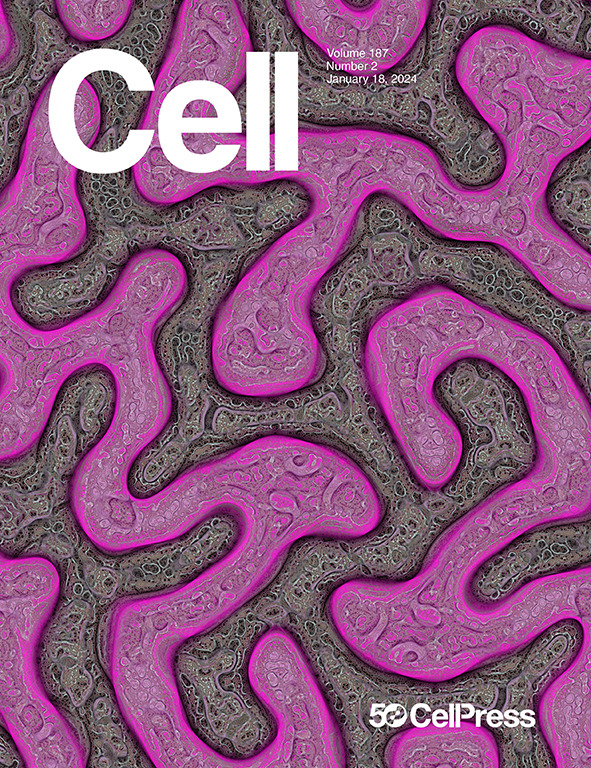RNA G-quadruplexes form scaffolds that promote neuropathological α-synuclein aggregation
IF 42.5
1区 生物学
Q1 BIOCHEMISTRY & MOLECULAR BIOLOGY
引用次数: 0
Abstract
Synucleinopathies, including Parkinson’s disease, dementia with Lewy bodies, and multiple system atrophy, are triggered by α-synuclein aggregation, triggering progressive neurodegeneration. However, the intracellular α-synuclein aggregation mechanism remains unclear. Herein, we demonstrate that RNA G-quadruplex assembly forms scaffolds for α-synuclein aggregation, contributing to neurodegeneration. Purified α-synuclein binds RNA G-quadruplexes directly through the N terminus. RNA G-quadruplexes undergo Ca2+-induced phase separation and assembly, accelerating α-synuclein sol-gel phase transition. In α-synuclein preformed fibril-treated neurons, RNA G-quadruplex assembly comprising synaptic mRNAs co-aggregates with α-synuclein upon excess cytoplasmic Ca2+ influx, eliciting synaptic dysfunction. Forced RNA G-quadruplex assembly using an optogenetic approach evokes α-synuclein aggregation, causing neuronal dysfunction and neurodegeneration. The administration of 5-aminolevulinic acid, a protoporphyrin IX prodrug, prevents RNA G-quadruplex phase separation, thereby attenuating α-synuclein aggregation, neurodegeneration, and progressive motor deficits in α-synuclein preformed fibril-injected synucleinopathic mice. Therefore, Ca2+ influx-induced RNA G-quadruplex assembly accelerates α-synuclein phase transition and aggregation, potentially contributing to synucleinopathies.

RNA G-四重链形成支架,促进神经病理α-突触核蛋白聚集
包括帕金森病、路易体痴呆症和多系统萎缩在内的突触核蛋白病是由α-突触核蛋白聚集引发的,从而引发进行性神经变性。然而,细胞内α-突触核蛋白的聚集机制仍不清楚。在此,我们证明了 RNA G-四联体组装形成了α-突触核蛋白聚集的支架,从而导致神经退行性变。纯化的α-突触核蛋白通过N末端直接与RNA G-四联体结合。RNA G-四联体在 Ca2+ 诱导下发生相分离和组装,加速了α-突触核蛋白的溶胶-凝胶相转变。在经过α-突触核蛋白预成纤维处理的神经元中,突触mRNA组成的RNA G-四联体在过量的细胞质Ca2+流入时与α-突触核蛋白共同聚集,导致突触功能障碍。利用光遗传学方法强迫 RNA G-四联体组装会诱发α-突触核蛋白聚集,导致神经元功能障碍和神经退行性变。服用原卟啉 IX 原药 5-aminolevulinic acid 可以防止 RNA G-quadruplex 相分离,从而减轻α-突触核蛋白聚集、神经变性以及α-突触核蛋白预成纤维注射突触核蛋白病小鼠的进行性运动障碍。因此,Ca2+流入诱导的RNA G-四联体组装加速了α-突触核蛋白的相变和聚集,有可能导致突触核蛋白病。
本文章由计算机程序翻译,如有差异,请以英文原文为准。
求助全文
约1分钟内获得全文
求助全文
来源期刊

Cell
生物-生化与分子生物学
CiteScore
110.00
自引率
0.80%
发文量
396
审稿时长
2 months
期刊介绍:
Cells is an international, peer-reviewed, open access journal that focuses on cell biology, molecular biology, and biophysics. It is affiliated with several societies, including the Spanish Society for Biochemistry and Molecular Biology (SEBBM), Nordic Autophagy Society (NAS), Spanish Society of Hematology and Hemotherapy (SEHH), and Society for Regenerative Medicine (Russian Federation) (RPO).
The journal publishes research findings of significant importance in various areas of experimental biology, such as cell biology, molecular biology, neuroscience, immunology, virology, microbiology, cancer, human genetics, systems biology, signaling, and disease mechanisms and therapeutics. The primary criterion for considering papers is whether the results contribute to significant conceptual advances or raise thought-provoking questions and hypotheses related to interesting and important biological inquiries.
In addition to primary research articles presented in four formats, Cells also features review and opinion articles in its "leading edge" section, discussing recent research advancements and topics of interest to its wide readership.
 求助内容:
求助内容: 应助结果提醒方式:
应助结果提醒方式:


